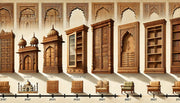
History of Carved Almirahs in Indian Furniture
The traditional Indian household embraces carved almirahs which served as essential status symbols of elegance and cultural traditions. These storage items hold dual utility because they serve their storage function in addition to their artistic value through their detailed visual appearance. As Indian cultural heritage evolved through time carved almirahs transformed their style while altering their usage and materials.
Origins and Evolution
Carved almirahs in Indian furniture first appeared during the royal era of ancient India. Wooden Sandook and Patara furniture served as containers to store valued goods and garments along with written documents. The advancement of woodworking technology resulted in chests developing into advanced almirahs characterized by doors and shelves. When almira designs spread through royal palaces they witnessed artisans add natural as well as mythical components and Mughal architectural elements by utilizing their hand-carving skills in wood.
During the Mughal era woodworkers added detailed floral patterns together with Persian decorative elements to their carvings. Much of the Indo-Persian artistry from the past remains visible in numerous antique almirahs. European colonial influence shaped wooden almirah designs through the introduction of mirrors combined with modern functional elements during the passing of time.
Regional Styles and Craftsmanship
Multiple parts of India created their distinctive woodcarving techniques throughout history.
1.Rajasthan develops remarkable woodworking masterpieces featuring ornate floral alongside animal elements.
2. Gujarat - Famous for delicate inlay work using mother of pearl and ivory.
3. Kerala - Preferred traditional designs with bold, deep carvings on rosewood and teak.
4. Punjab - Focused on sturdy designs with minimal yet elegant carvings.
The distinct carvings across Indian regions produce diverse wooden almirah styles that meet the needs of customers from small compact rooms to broader spacious areas.
Traditional vs. Modern Wooden Almirahs
Modern lifestyles require a diversified demand for the traditional handmade almirahs. People are increasingly showing interest in the modern showroom exhibitions of wooden almirah designs. The contemporary home market prefers wooden almirah with dressing table and wooden almirah with mirror price among other versions that include wooden almirah with glass door.
The residents of cities prefer getting wooden almirah small size models to fit their small apartment dimensions. The market shows increasing interest for wall-mounted wooden almirah as space-efficient choices alongside wooden almirah designs with sliding doors that make navigation easier through tight spaces.
Versatility and Functionality
Carved almirahs now exist outside of traditional bedroom use. Indian households today use wooden almirahs for their diverse requirements throughout their homes.
Wooden almirah for kitchen as pantry storage or crockery units.
The study area receives functionality through wooden book cabinets known as almirahs.
Wooden almirah with mandir for home temples.
Wooden almirah with TV cabinet for living rooms.
These designs work as storage solutions that combine design excellence with practice efficiency. The wooden almirah with mirror design functions ideally for bedroom storage needs in addition to dressing necessities.
Color and Design Trends
House owners of the present era choose distinctive combinations of colors together with unique finishes. The color selection for wooden almirah undergoes a trend shift to include the modern shades of white, grey and pastel tones. Modern interior design schemes find their ideal match with the color combinations of wooden almirah.
Wooden almirah wallpaper and wooden almirah sunmica design have become popular choices because of their customizability features. Modern wooden almirah that use glass doors present a contemporary sophisticated appearance.
Maintenance and Durability
-
Wooden almirahs need regular upkeep to maintain their attractiveness alongside their enduring quality. It is essential to:
-
Wipe the almirah with a dry soft cloth to dust off the surface.
Periodical polishing results in a glamorous appearance.
-
The almirah should be protected against moisture and direct sunlight to avoid warping and fading.
-
The wooden almirah lock along with heavy-duty handles serves both security needs and practical use functions for the almirah.








